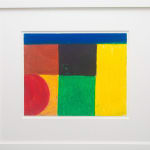
Gerald Jackson
20 x 22 1/2 inches (framed)
Further images
Provenance
Ex. coll:
The Artist; to Allan Stone Gallery, New York, NY.
Inventory label: Allan Stone Gallery: GJ36
GJ36-Jackson, Gerald-Untitled-mixed media, pastel on paper and plexi frame
Barcode: 8275
Publications
https://bombmagazine.org/articles/gerald-jackson/
Gerald Jackson
(American, b. 1936)
Geometric Abstraction
oil pastel on paper
10 3/4 x 13 1/2 inches
20 x 22 1/2 inches (framed)
framed to museum conservation standards with 8 ply mat and white frame with state of the art Optium acrylic
Gerald Jackson credits jazz musicians with creating "a space within that culture for black artist." In an interview with fellow African-American artist Stanley Whitney for BOMB's The Oral History Project he said, I think what the jazz musicians did was create a situation or an environment where improvisation is one of the leading ways of going at things. When you're improvising, you're working out of your subconscious, which is what the Surrealists had done - the subconscious being the source of art."
Jackson was born on the South Side of Chicago in 1936. As Jackson describes it, he was raised by gangsters. His father and brothers ran a numbers racket and a limousine business. During elementary school he attended a racially mixed school and they were relatively well-off. The Mafia pushed African-Americans, and Jackson's family, out of the limo business. From that point on, Jackson's daily life became decidedly "South Side Chicago" and segregated.
When Jackson was twelve, his parents divorced. He went to live with his father in a male-centric world. Jackson attended vocational high school and didn't go to college because it wasn't encouraged. His first interaction with the art world was on a date to the Art Institute of Chicago. It inspired him to take night painting classes at the School at the Art Institute while he worked at the Post Office. Following a two-year stint in the Army, Jackson returned to Chicago and began hanging out with the bohemian crowd near the University of Chicago.
In 1936 Jackson moved to The Village in New York City and quickly got a work scholarship at the Brooklyn Museum School to study drawing and painting. The scene in New York City during the mid 60's was fluid; artists and musicians mingled easily. Many African-American artists congregated on the Lower East Side. It was there that Jackson got to know Bob Thompson, Jimi Hendrix and Charlie Parker.
Jackson was introduced to the legendary art dealer Allan Stone in 1968. Stone liked his work and supported Jackson. Stone exhibited Jackson's work every other year alternating between abstract and figurative works as Jackson refused to be limited by subject matter. The dealer also purchased work directly from Jackson and included his work in general shows. At the time Jackson was living on the Bowery where other artists like Michael Goldberg, Roy Lichtenstein, James Rosenquist and Willem de Kooning also lived. Man people feel that Jackson's work pre-figured Grafitti Art of the 1980's, most particularly Basquiat's work.
Tattoo, Kid and Geometric Abstraction showcase Gerald Jackson's incredible sense of color and composition. One can also see how his work informs an relates to 1980's Graffiti Art and the work of Elizabeth Murray.
